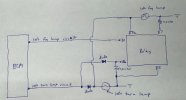What I've described is a switchback process.
Yes, in the sense that it’s “switching back” and forth between the turn signal and the fog lamp, but not in the sense of what the OP wanted to accomplish in this thread.
It doesn’t matter how many, or what kind of relays you use, all that is going to happen when you hit the turn signal is the turn signal circuit will energize the coil when it blinks “on”, which will open the fog lamp circuit. Then, while the turn signal is still activated and blinks “off”, it will close the fog lamp circuit, turning it back on. So, all you’ll be getting is a “flicker” from the fog lamp from the coil energizing and de-energizing when the turn signal is blinking (more on what needs to be done to make it a true fog lamp drop out switchback circuit below).
Where does that message pop up? Be pretty funny since it would also blink.
Like described above, when the turn signal energizes the coil, it opens the fog lamp circuit from the BCM, and illuminates the fog lamp via the turn signal circuit from the BCM. When the BCM senses the fog lamp circuit is open, it will display a message in the EVIC saying that fog lamp is out, and store a fault in the BCM.
This is what the original intent of behavior of the fog lamps are to be for the OP of this thread:
1) The factory fog lamps operate normally under normal circumstances.
2) When a turn signal is activated, the corresponding fog lamp will “drop out”, and blink “on-off-on-off” along with the factory turn signal in the headlight housing.
In order to accomplish this, you need a true switchback module, which is basically a relay and capacitor. The sketch below is what is needed:

You can see that the fog lamps will be on when they normally would, via 87a being normally closed.
When the turn signal is activated, the “on” blink energizes the coil and charges the capacitor. This opens the fog lamp circuit and illuminates it with the turn signal circuit’s “on” blink. At the same time, the fog lamp circuit has switched over to 87, which has a resistor to present the BCM with the fog lamp load it’s looking for, so not to throw a fog lamp out fault.
While the turn signal is still activated, the “off” blink will de-energize the coil, but the charge in the capacitor from the “on” blink will hold 87a open, and the fog light will shut off in unison with the turn signal lamp. The diode between the capacitor and turn signal circuit is to prevent the capacitor’s charge from bleeding off to the turn signal lamp.












